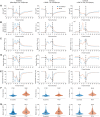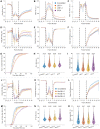LiveCellMiner: A new tool to analyze mitotic progression
- PMID: 35797385
- PMCID: PMC9262191
- DOI: 10.1371/journal.pone.0270923
LiveCellMiner: A new tool to analyze mitotic progression
Abstract
Live-cell imaging has become state of the art to accurately identify the nature of mitotic and cell cycle defects. Low- and high-throughput microscopy setups have yield huge data amounts of cells recorded in different experimental and pathological conditions. Tailored semi-automated and automated image analysis approaches allow the analysis of high-content screening data sets, saving time and avoiding bias. However, they were mostly designed for very specific experimental setups, which restricts their flexibility and usability. The general need for dedicated experiment-specific user-annotated training sets and experiment-specific user-defined segmentation parameters remains a major bottleneck for fully automating the analysis process. In this work we present LiveCellMiner, a highly flexible open-source software tool to automatically extract, analyze and visualize both aggregated and time-resolved image features with potential biological relevance. The software tool allows analysis across high-content data sets obtained in different platforms, in a quantitative and unbiased manner. As proof of principle application, we analyze here the dynamic chromatin and tubulin cytoskeleton features in human cells passing through mitosis highlighting the versatile and flexible potential of this tool set.
Conflict of interest statement
The authors have declared that no competing interests exist.
Figures





Similar articles
-
An automatic method for robust and fast cell detection in bright field images from high-throughput microscopy.BMC Bioinformatics. 2013 Oct 4;14:297. doi: 10.1186/1471-2105-14-297. BMC Bioinformatics. 2013. PMID: 24090363 Free PMC article.
-
MAARS: a novel high-content acquisition software for the analysis of mitotic defects in fission yeast.Mol Biol Cell. 2017 Jun 15;28(12):1601-1611. doi: 10.1091/mbc.E16-10-0723. Epub 2017 Apr 27. Mol Biol Cell. 2017. PMID: 28450455 Free PMC article.
-
Rapid analysis and exploration of fluorescence microscopy images.J Vis Exp. 2014 Mar 19;(85):51280. doi: 10.3791/51280. J Vis Exp. 2014. PMID: 24686220 Free PMC article.
-
Open source tools for fluorescent imaging.Methods Enzymol. 2012;504:393-417. doi: 10.1016/B978-0-12-391857-4.00020-3. Methods Enzymol. 2012. PMID: 22264546 Review.
-
Feedback regulation of microscopes by image processing.Dev Growth Differ. 2013 May;55(4):550-62. doi: 10.1111/dgd.12056. Epub 2013 Apr 18. Dev Growth Differ. 2013. PMID: 23594233 Review.
Cited by
-
Predicting cell cycle stage from 3D single-cell nuclear-stained images.Life Sci Alliance. 2025 Apr 3;8(6):e202403067. doi: 10.26508/lsa.202403067. Print 2025 Jun. Life Sci Alliance. 2025. PMID: 40180577 Free PMC article.
-
Automatic detection of cell-cycle stages using recurrent neural networks.PLoS One. 2024 Mar 11;19(3):e0297356. doi: 10.1371/journal.pone.0297356. eCollection 2024. PLoS One. 2024. PMID: 38466708 Free PMC article.
-
Predicting cell cycle stage from 3D single-cell nuclear-stained images.bioRxiv [Preprint]. 2024 Sep 1:2024.08.30.610553. doi: 10.1101/2024.08.30.610553. bioRxiv. 2024. Update in: Life Sci Alliance. 2025 Apr 03;8(6):e202403067. doi: 10.26508/lsa.202403067. PMID: 39257739 Free PMC article. Updated. Preprint.
-
The DEAD-box helicase eIF4A1/2 acts as RNA chaperone during mitotic exit enabling chromatin decondensation.Nat Commun. 2025 Mar 11;16(1):2434. doi: 10.1038/s41467-025-57592-1. Nat Commun. 2025. PMID: 40069174 Free PMC article.
-
Denoising diffusion probabilistic models for generation of realistic fully-annotated microscopy image datasets.PLoS Comput Biol. 2024 Feb 20;20(2):e1011890. doi: 10.1371/journal.pcbi.1011890. eCollection 2024 Feb. PLoS Comput Biol. 2024. PMID: 38377165 Free PMC article.
References
Publication types
MeSH terms
LinkOut - more resources
Full Text Sources
Research Materials

